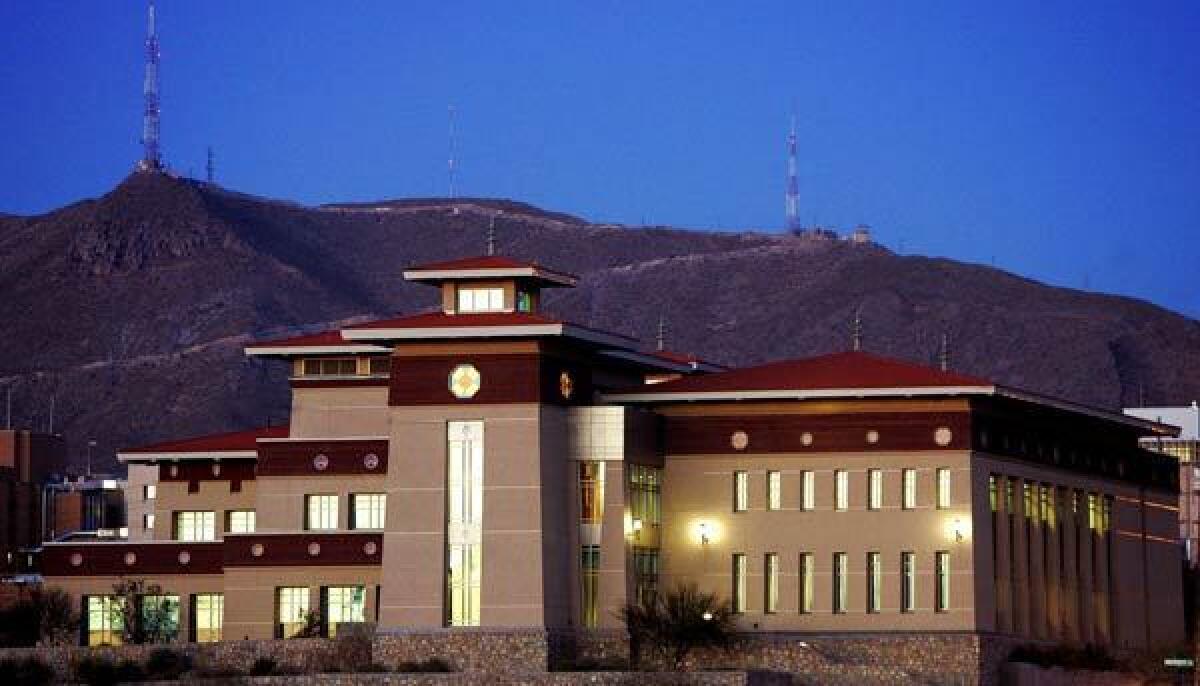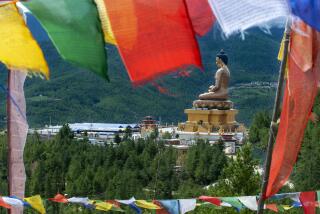El Paso: Bhutan’s kingly style reflected in UTEP architecture

- Share via
Reporting from El Paso — — If you want to travel to the remote Himalayan kingdom of Bhutan, you will need two days, minimum, travel time on several planes and thousands of dollars. Or you can come to El Paso.
Since 1917, structures on the campus of the former Texas State School of Mines and Metallurgy have been built in the unique style of Bhutan’s majestic dzongs, fortresses constructed with sloping 8-foot-thick walls and red-colored roofs. The school, now known as the University of Texas at El Paso, or UTEP, has grown to 77 buildings, all constructed or retrofitted around the theme.
Even the shelter housing an ATM, the guard kiosks and a Hilton Garden Inn on the edge of campus are designed à la Bhutan. UTEP President Diana Natalicio has said that the school’s parking garages are the only ones in the world in the Bhutanese style because in Bhutan no such structure exists. (The country didn’t have roads until 40 years ago.) A $2-million pedestrian overpass on the campus, unveiled in August, continues the theme.
In recent years, UTEP has intensified its relationship with the kingdom, thanks to Natalicio and her affinity for the school’s unusual heritage.
Bhutanese artifacts grace nearly every cranny of the campus, adding a touch of authenticity to this faux Bhutan. Fifteen Buddhist prayer flags flutter outside the Centennial Museum, where well-wishers can spin a prayer wheel that was the gift of the Bhutanese people in 2003. Three 16-foot-long, intricately embroidered scrolls known as thongdrels hang on display, two in the library, a 1984 structure that Willie Quinn of UTEP’s Heritage Commission declares is “more Bhutanese than something in Bhutan.”
Although there are no espresso bars in any lobbies in the Land of the Thunder Dragon — at least not yet — the magnificent 15-foot hand-painted altar adjacent to the coffee stand in the UTEP library does make it clear that this isn’t your average public university campus. A copy of the world’s largest book (as certified by Guinness World Records) underscores the connection. “Bhutan: A Visual Odyssey Across the Last Himalayan Kingdom” is 5 by 8 feet and weighs 133 pounds.
Displayed throughout the library are instruments essential to traditional Bhutanese music, such as a yangchen, or dulcimer, and a dramyen, a Tibetan lute. In a nod to the country’s national sport, a traditional Bhutanese bow and a quiver of arrows also are on display.
About the only aspects of the 366-acre campus that don’t resemble Bhutan are the Sun Bowl and the Don Haskins Center, where UTEP’s Miners basketball teams play.
What does El Paso have to do with a tiny country that borders India, Nepal and Tibet? The reason for this unusual connection has to do with two people who never met.
John Claude White, a British political officer, traveled to Bhutan at the turn of the 20th century and was the only foreigner present in 1907 at the coronation of Bhutan’s first king. White filed one of the first dispatches about the mysterious kingdom to be published, a 105-page report in the April 1914 National Geographic with 88 photographs he shot during his visit.
“It is impossible to find words to express adequately the wonderful beauty and variety of scenery I met with during my journeys, the grandeur of the magnificent snow peaks and the picturesque charm of the many wonderful forts and other buildings I came across,” White wrote, “but I hope my photographs may.”
Half a world away, they inspired Kathleen Worrell, wife of the school’s dean. When fire ravaged the campus, she suggested to her husband that it be rebuilt in the style of this faraway place; she was said to have seen a resemblance between El Paso’s Franklin Mountains and the Himalayas. Architects were commissioned. With only the White photographs and his vivid language to work from, they came up with blueprints for four new buildings, setting a precedent for the look of the school.
The Bhutanese worked without written plans. “I wish our new buildings in Bhutan could be so finely built,” the then-queen of Bhutan wrote to UTEP in the late ‘60s, after being sent photographs of the campus.
Bhutan didn’t open up to outsiders until 1974, and a UTEP graduate just completed a year in Bhutan as its first international artist in residence. The school is even offering a chance to visit the real thing Dec. 29-Jan.15 for the kingly sum of $7,995 (www.admin.utep.edu/Default.aspx?tabid=70181). But as the ties grow closer, there’s one Bhutanese element you’re not likely to see in El Paso: colorful painted phalli that adorn the sides of buildings to ward off evil spirits.
Lisa Napoli is the author of “Radio Shangri-La: What I Learned in Bhutan, the Happiest Kingdom on Earth.”
Lisa Napoli is the author of “Radio Shangri-La: What I Learned in Bhutan, the Happiest Kingdom on Earth.”
More to Read
Sign up for The Wild
We’ll help you find the best places to hike, bike and run, as well as the perfect silent spots for meditation and yoga.
You may occasionally receive promotional content from the Los Angeles Times.




